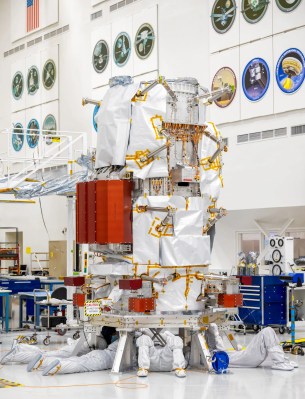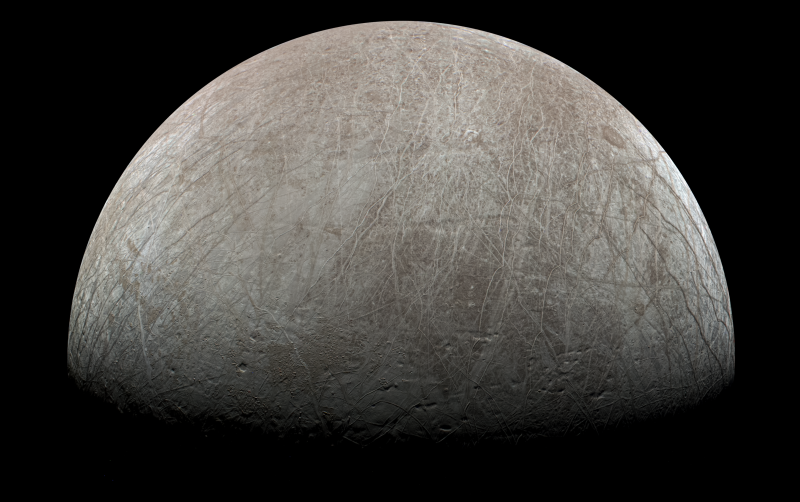Are we alone? While we certainly have lots of strange lifeforms to choose from as companions here on our blue marble, we have yet to know if there’s anything else alive out there in the vastness of space. One of the most promising places to look in our own solar neighborhood is Europa.
 Underneath its icy surface, Europa appears to have a sea that contains twice as much water as we have here on Earth. Launching later this year and arriving in 2030, NASA’s Europa Clipper will provide us with our most up-close-and-personal look at the Jovian Moon yet. In conjunction with observations from the ESA’s Jupiter Icy Moons Explorer (JUICE), scientists hope to gain enough new data to see if the conditions are right for life.
Underneath its icy surface, Europa appears to have a sea that contains twice as much water as we have here on Earth. Launching later this year and arriving in 2030, NASA’s Europa Clipper will provide us with our most up-close-and-personal look at the Jovian Moon yet. In conjunction with observations from the ESA’s Jupiter Icy Moons Explorer (JUICE), scientists hope to gain enough new data to see if the conditions are right for life.
Given the massive amounts of radiation in the Jovian system, Europa Clipper will do 50 flybys of the moon over the course of four years to reduce damage to instruments as well as give it windows to transmit data back to Earth with less interference. With enough planning and luck, the mission could find promising sites for a future lander that might be able to better answer the question of if there actually is life on other worlds.
Some of the other moons around Jupiter could host life, like Io. Looking for life a little closer? How about on our nearest neighbor, Venus, or the ever popular Mars?

















haven’t done this in a while because it’s a bit of a put-down.
But this article is essentially saying “hey we’re launching a rocket this year, and who knows what we’ll find”. Hardly an article related to hacking, but I’m sure some very creative people will come up with a way that this is a hack after all.
This is tech news, which is part of Hackaday. I personally enjoy reading it, wouldn’t have read it anywhere else I go for information (I do not subscribe to any space news)
Seeing that not every launch succeeds, and out of those launches not every probe makes it, it is a hack and a big one to put a probe in another celestial object. Even if the article is a bit light in hacky details. Still looking for more info on the computer aboard the voyagers, block diagrams and high level descriptions do not cut it at this point. :)
I’m just excited for the Europa mission and all the things we’ll learn and innovate. It’s tangential, it’s fine imo
This is nothing more than more crap on top of more crap….we already know that there’s water….water carries microbial bio things..just land an craft into Jupiter’s atmosphere already and call up the rocky core bit bye bit… we’ve been doing this for years now…all we need is an larger model so people could get their freak on🤣
Even ignoring the engineering challenges in “taking a sample” through a mile of extraterrestrial ice, Nasa doesn’t want their multimillion probe to land on an incline and tip into a crevice.
Even the Apollo program did a flyby mission to determine landing sites.
Are you confusing the two celestial bodies or are you suggesting that we “just” land on Jupiter’s core and bring something back out? Lol okay bro
I’m not one of the “Where’s the hack?” crowd. I really do like to see these types of posts from time to time here.
But I have have to ask: What prompted this post? There’s not a lot of meat to chew on here. It’s not news, and it’s not new, and we are a half-year away from launch. To add insult, it links to a grubbing MIT Tech Review post.
It doesn’t even include a link to the canonical https://europa.nasa.gov/
You are now one of the “where’s the hack” crowd
ALL THESE WORLDS ARE YOURS – EXCEPT EUROPA.
ATTEMPT NO LANDING THERE.
We don’t listen to giant, black rectangles!
Racist!
I prefer my rectangles to be huwite and pure
this comment should be added to the hackaday blacklist.
Why? What did I say that was offensive? I’m quoting from a book.
I’ve been following this on the NASA JPL You Tube channel for a couple years now, Here is the link.
https://www.youtube.com/watch?v=RDzlfITCXYc
The launch is upcoming in October aboard a Space X Falcon Heavy I believe.